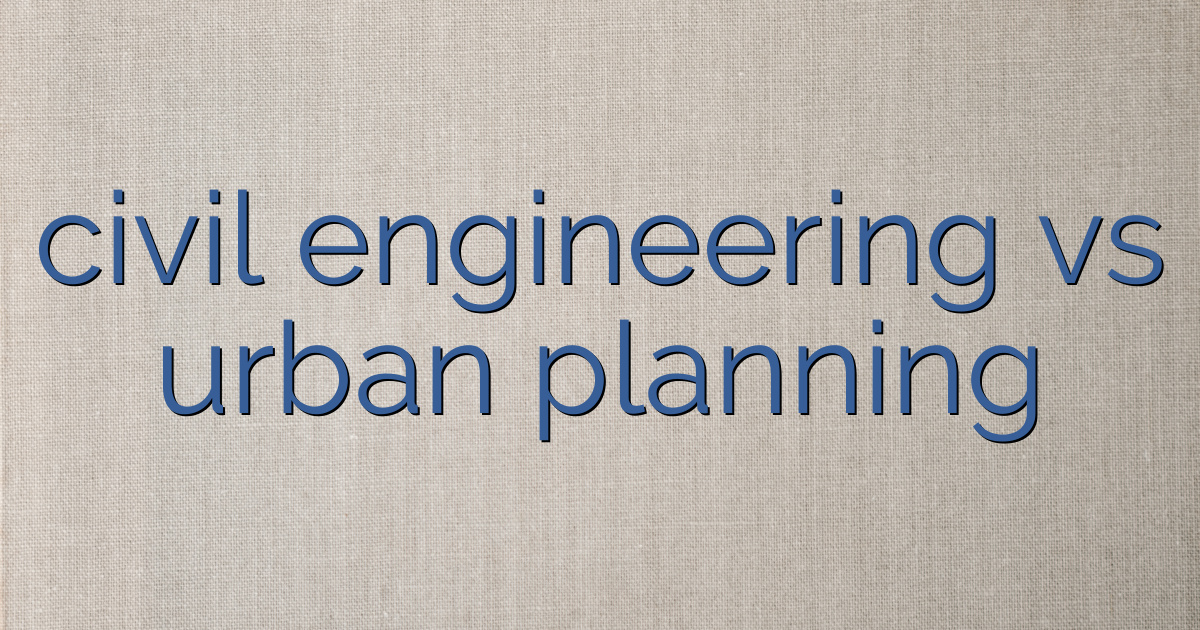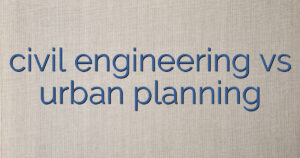
Civil engineering and urban planning are two distinct yet interrelated fields that are essential to the development and improvement of our cities and infrastructure.
While both disciplines focus on the planning and construction of buildings, roads, and other facilities, they differ in their approach and methodology.
Civil engineering is primarily concerned with the design and construction of physical infrastructure, while urban planning focuses on the development and management of cities and communities.
Understanding Civil Engineering Civil engineering is a branch of engineering that deals with the design, construction, and maintenance of the built environment.
Civil engineers are responsible for the design and construction of infrastructure such as roads, bridges, buildings, and water supply systems.
They use their expertise in mathematics, physics, and other sciences to ensure that structures are safe, efficient, and sustainable.
Understanding Urban Planning Urban planning is the process of designing and managing the physical, social, and economic development of cities, towns, and communities.
Urban planners work to create livable and sustainable communities by envisioning how people and places will interact in the future.
They take into account factors such as population growth, land use, transportation, and environmental sustainability when developing plans for the future.
Table of Contents
Key Takeaways – Civil Engineering vs Urban Planning
- Civil engineering and urban planning are two distinct yet interrelated fields that play crucial roles in shaping the built environment.
- Civil engineering primarily deals with the design and construction of physical infrastructure, while urban planning focuses on the development and management of cities and communities.
- Both disciplines contribute to the development and improvement of our cities and infrastructure, and possess unique focuses and methodologies.
Understanding Civil Engineering
Scope of Civil Engineering
Civil engineering is a branch of engineering that deals with the design, construction, and maintenance of the built environment, including structures, transportation systems, water supply systems, and more. Civil engineers are responsible for ensuring that the infrastructure that we use every day is safe, efficient, and sustainable.
Key Responsibilities of a Civil Engineer
Civil engineers have a wide range of responsibilities, including:
- Designing and planning construction projects
- Analyzing survey reports, maps, and other data
- Developing construction plans and specifications
- Ensuring that construction projects comply with building codes and regulations
- Managing construction projects and supervising workers
- Conducting site visits and inspections to ensure that construction projects are progressing as planned
- Testing materials to ensure that they meet quality standards
- Collaborating with architects, contractors, and other professionals to ensure that construction projects are completed on time and within budget
Challenges in Civil Engineering
Civil engineering is a challenging field that requires a high level of technical expertise and attention to detail. Some of the challenges that civil engineers face include:
- Managing complex projects with tight deadlines
- Ensuring that construction projects are safe and comply with building codes and regulations
- Balancing the needs of different stakeholders, including clients, contractors, and government agencies
- Keeping up with advances in technology and materials
- Addressing environmental concerns and ensuring that construction projects are sustainable
Despite these challenges, civil engineering is a rewarding field that offers opportunities to make a positive impact on society.
How is Urban Planning Different from Structural Engineering in the Field of Civil Engineering?
Urban planning and structural engineering are two distinct fields within civil engineering. While urban planning focuses on the layout and development of cities and communities, structural engineering is primarily concerned with designing and creating the physical structures within those spaces. These civil engineering differences explained highlight the specialized nature of both disciplines.
Understanding Urban Planning
Scope of Urban Planning
Urban planning is a field that deals with the design and development of urban areas, including cities and towns. This involves the management of land use, transportation systems, public facilities, and other aspects that affect the quality of life of the residents. Urban planning is a multidisciplinary field that draws on knowledge from various disciplines such as architecture, engineering, geography, sociology, and economics.
Key Responsibilities of an Urban Planner
Urban planners are responsible for developing plans and policies that promote the sustainable development of urban areas. They work with government officials, community groups, and other stakeholders to identify the needs of the community and develop plans that address those needs. Some of the key responsibilities of an urban planner include:
- Conducting research and analysis to identify the needs of the community
- Developing plans and policies that promote sustainable development
- Collaborating with stakeholders to ensure that plans are aligned with community needs
- Managing the implementation of plans and policies
- Monitoring and evaluating the impact of plans and policies
Challenges in Urban Planning
Urban planning is a complex and challenging field that requires planners to balance multiple competing interests. One of the biggest challenges in urban planning is managing growth and development while preserving the character of the community. Rapid growth can lead to overcrowding, traffic congestion, and other problems that can negatively impact the quality of life of residents. Another challenge is ensuring that plans and policies are equitable and inclusive, and that they address the needs of all members of the community, including low-income residents and marginalized groups.
Urban planners also face challenges related to funding and resources. Developing and implementing plans and policies requires significant resources, and planners must work within tight budgets and limited resources. Finally, urban planners must navigate complex regulatory frameworks and work with a variety of stakeholders, including government officials, community groups, and private developers, to ensure that plans and policies are implemented effectively.
Overall, urban planning is a critical field that plays a vital role in shaping the built environment and promoting the sustainable development of urban areas. By understanding the scope of urban planning, the key responsibilities of an urban planner, and the challenges that planners face, we can better appreciate the important work that urban planners do.
Comparative Analysis
Education and Training
Civil engineering and urban planning are both highly specialized fields that require a significant amount of education and training. Civil engineers typically need a bachelor’s degree in civil engineering or a related field, while urban planners may have a degree in urban planning, public policy, or a related field. Both fields may require additional certifications or licenses, depending on the specific job and location.
Job Prospects
Job prospects for civil engineers and urban planners are generally positive, although the specific job outlook may vary depending on the region and industry. According to the Bureau of Labor Statistics, employment of civil engineers is projected to grow 2% from 2020 to 2030, while employment of urban and regional planners is projected to grow 10% during the same period.
Impact on Society
Both civil engineering and urban planning have a significant impact on society. Civil engineers design and build the physical infrastructure that supports modern society, including roads, bridges, buildings, and water systems. Urban planners, on the other hand, design communities and cities, focusing on creating livable and sustainable environments for residents.
While both fields have a positive impact on society, they approach problem-solving in different ways. Civil engineers tend to focus on the technical and physical aspects of infrastructure design, while urban planners take a more holistic approach that considers the social, economic, and environmental impacts of their designs.
In conclusion, civil engineering and urban planning are both important fields that require a significant amount of education and training. While they have different approaches to problem-solving, both fields have a positive impact on society and offer promising job prospects for those interested in pursuing a career in either field.
What is the relationship between Urban Planning and Geography in the context of Civil Engineering and Urban Planning?
Urban planning and geography play a crucial role in civil engineering and urban planning. Geography provides the understanding of the physical environment, while urban planning ensures that cities are designed and developed in a sustainable and efficient manner. The relationship between the two disciplines is essential for creating functional and livable urban spaces.
Case Studies
Civil Engineering Projects
Civil engineering projects involve designing, constructing, and maintaining infrastructure such as roads, bridges, and buildings. One notable example of a civil engineering project is the Burj Khalifa in Dubai, which is currently the tallest building in the world. The Burj Khalifa stands at a height of 828 meters and has 163 floors. It was designed by Skidmore, Owings & Merrill, an American architectural firm, and constructed by South Korean company Samsung C&T.
Another example of a civil engineering project is the Panama Canal Expansion, which was completed in 2016. The expansion involved the construction of a new set of locks that allowed larger ships to pass through the canal. The project was led by the Panama Canal Authority and involved a consortium of international engineering firms.
Urban Planning Projects
Urban planning projects involve designing and managing the development of cities and communities. One notable example of an urban planning project is the High Line in New York City. The High Line is a public park built on an elevated freight rail line that runs through Manhattan’s Chelsea neighborhood. The project was designed by James Corner Field Operations, a landscape architecture firm, and Diller Scofidio + Renfro, an interdisciplinary design studio.
Another example of an urban planning project is the Masdar City in Abu Dhabi, which is a sustainable city designed to be powered entirely by renewable energy. The project was initiated by the Abu Dhabi Future Energy Company and designed by Foster + Partners, a British architectural firm. Masdar City includes features such as solar panels, wind turbines, and a network of pedestrian pathways to encourage walking and cycling.
Overall, both civil engineering and urban planning play important roles in shaping the built environment. Civil engineering projects focus on the physical infrastructure, while urban planning projects focus on the design and management of cities and communities.
